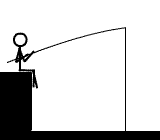Post by mastercatter on May 26, 2010 7:21:30 GMT -5
Northern Snakehead Fish
(Channa argus)
The Northern Snakehead is an invasive fish native to China, Russia and Korea.
Northern Snakeheads are highly invasive and have the potential to disrupt recreational and commercial fishing, harm native fish and wildlife, and impact our economy. Northern snakeheads are top predators capable of growing to at least three feet long and surviving throughout the continental US in a variety of habitats. With teeth similar to our pike and walleye, they are superb predators. They feed voraciously, primarily on other fish but also eat frogs, crayfish and aquatic insects. While they prefer weedy shallow waters, they can inhabit virtually any of our lakes and streams. They tolerate a wider range of oxygen levels than our native species. When oxygen is insufficient to support most of our native fish, snakeheads can breathe air and they may survive for days out of water in damp conditions. Young fish can move across the ground to access water. Snakeheads spawn multiple times each year with females releasing tens of thousands of eggs each time. Eggs hatch in one to two days during the summer and parents guard the young until they begin to feed. Upon hatching, snakeheads feed on zooplankton then begin consuming other fish larvae when they are less than an inch long.
What do they look like?
Tan to pale brown with dark brown blotches on sides and saddle-like markings on back.
Elongate body with long dorsal and anal fins.
Many sharp teeth.
Large mouth reaching far behind eyes.
Similar in appearance to the Bowfin.
(Channa argus)
The Northern Snakehead is an invasive fish native to China, Russia and Korea.
Northern Snakeheads are highly invasive and have the potential to disrupt recreational and commercial fishing, harm native fish and wildlife, and impact our economy. Northern snakeheads are top predators capable of growing to at least three feet long and surviving throughout the continental US in a variety of habitats. With teeth similar to our pike and walleye, they are superb predators. They feed voraciously, primarily on other fish but also eat frogs, crayfish and aquatic insects. While they prefer weedy shallow waters, they can inhabit virtually any of our lakes and streams. They tolerate a wider range of oxygen levels than our native species. When oxygen is insufficient to support most of our native fish, snakeheads can breathe air and they may survive for days out of water in damp conditions. Young fish can move across the ground to access water. Snakeheads spawn multiple times each year with females releasing tens of thousands of eggs each time. Eggs hatch in one to two days during the summer and parents guard the young until they begin to feed. Upon hatching, snakeheads feed on zooplankton then begin consuming other fish larvae when they are less than an inch long.
What do they look like?
Tan to pale brown with dark brown blotches on sides and saddle-like markings on back.
Elongate body with long dorsal and anal fins.
Many sharp teeth.
Large mouth reaching far behind eyes.
Similar in appearance to the Bowfin.








